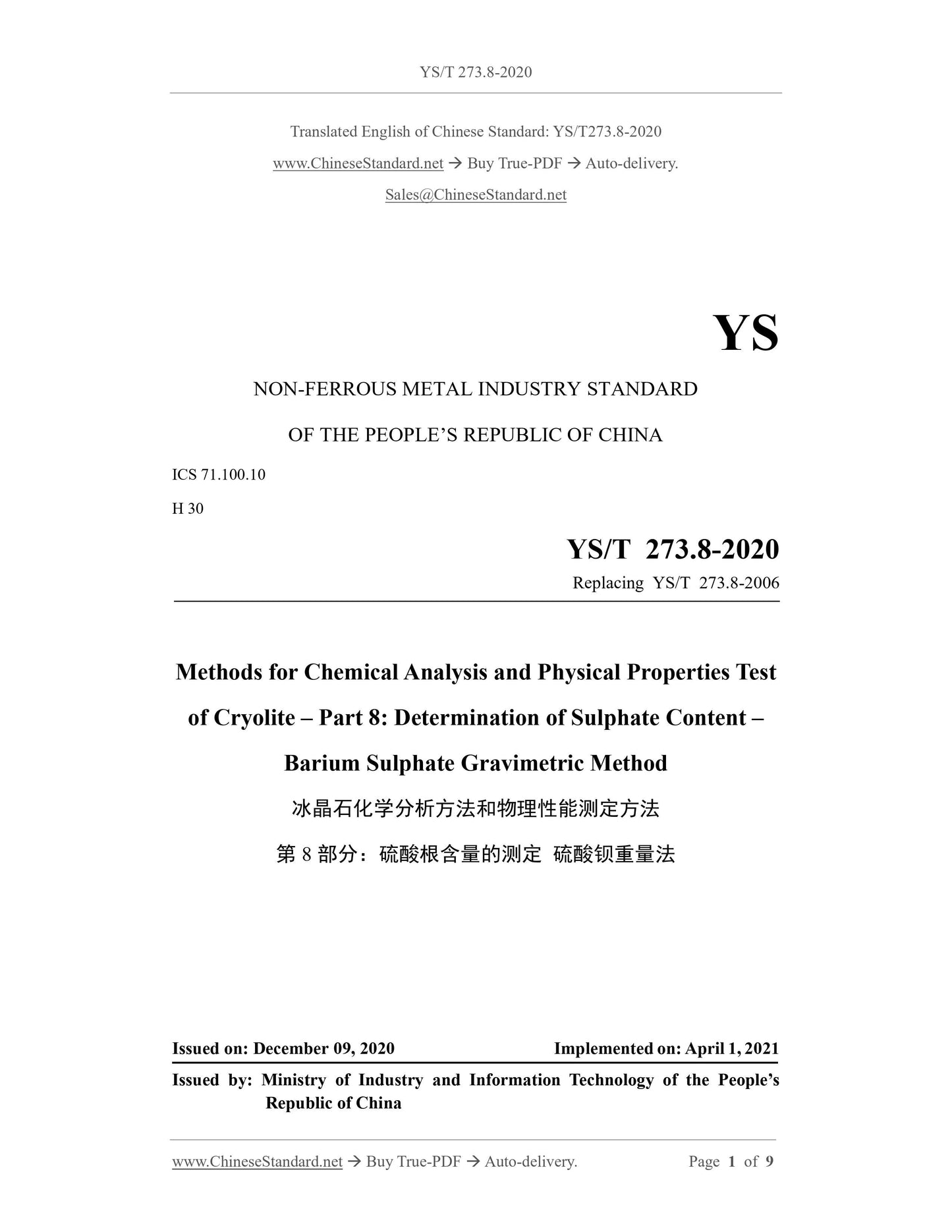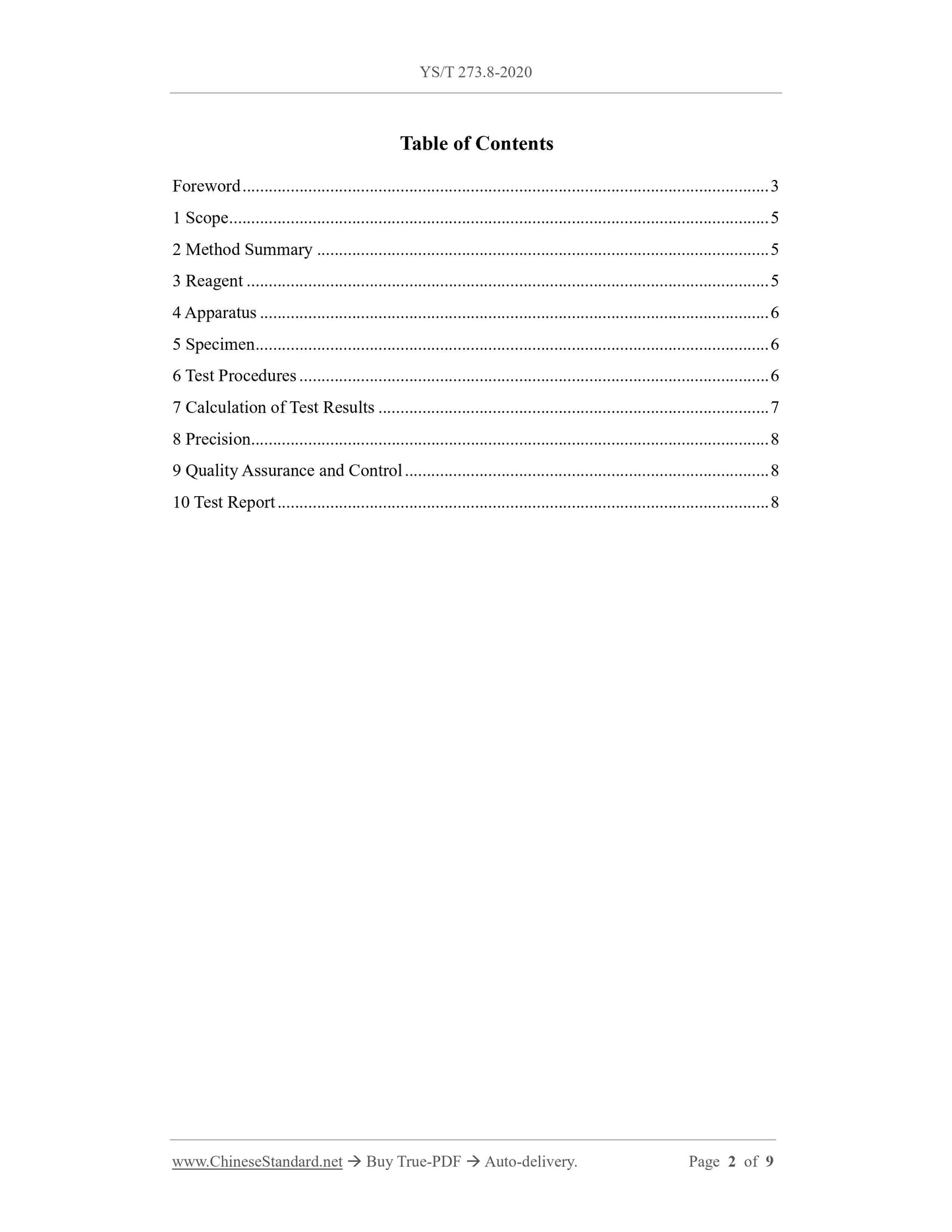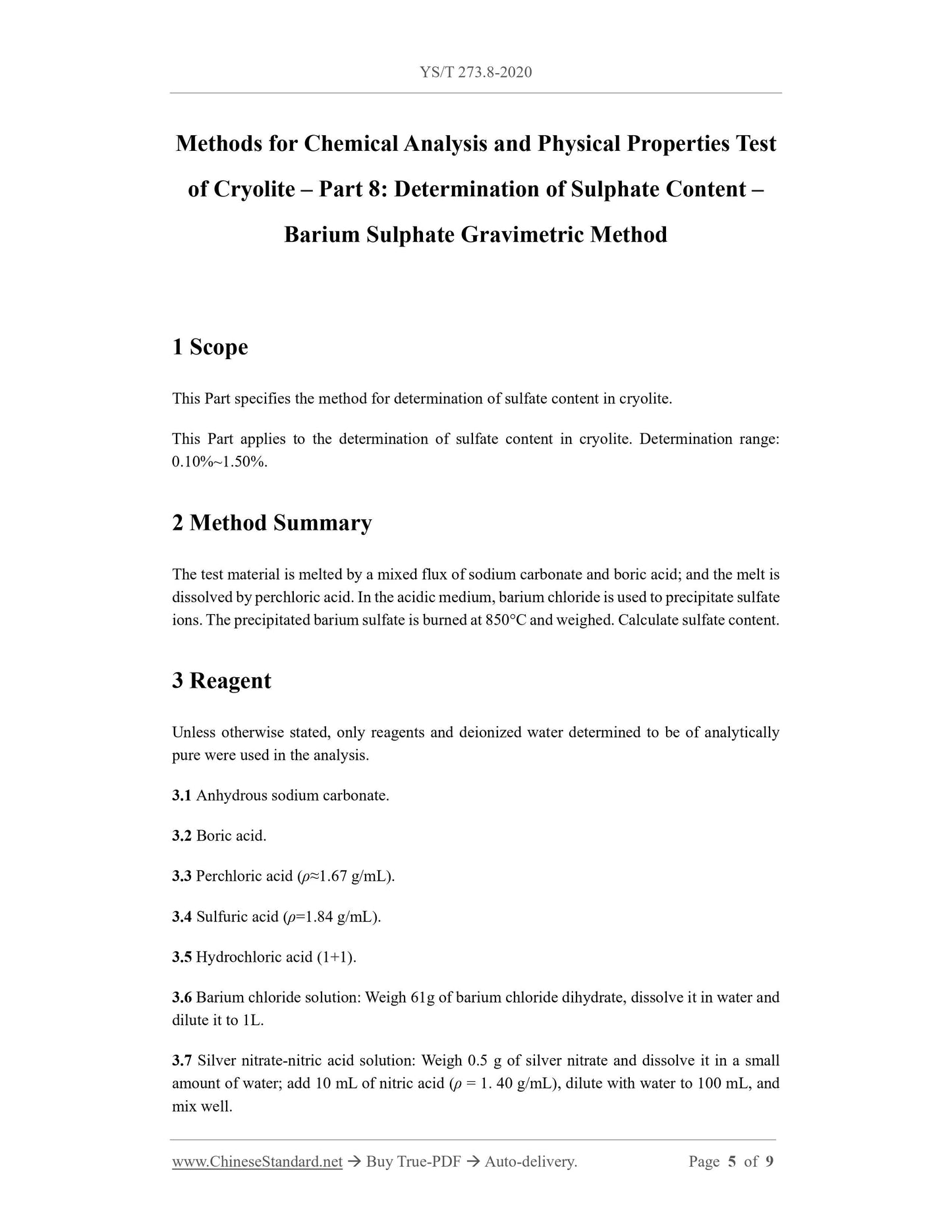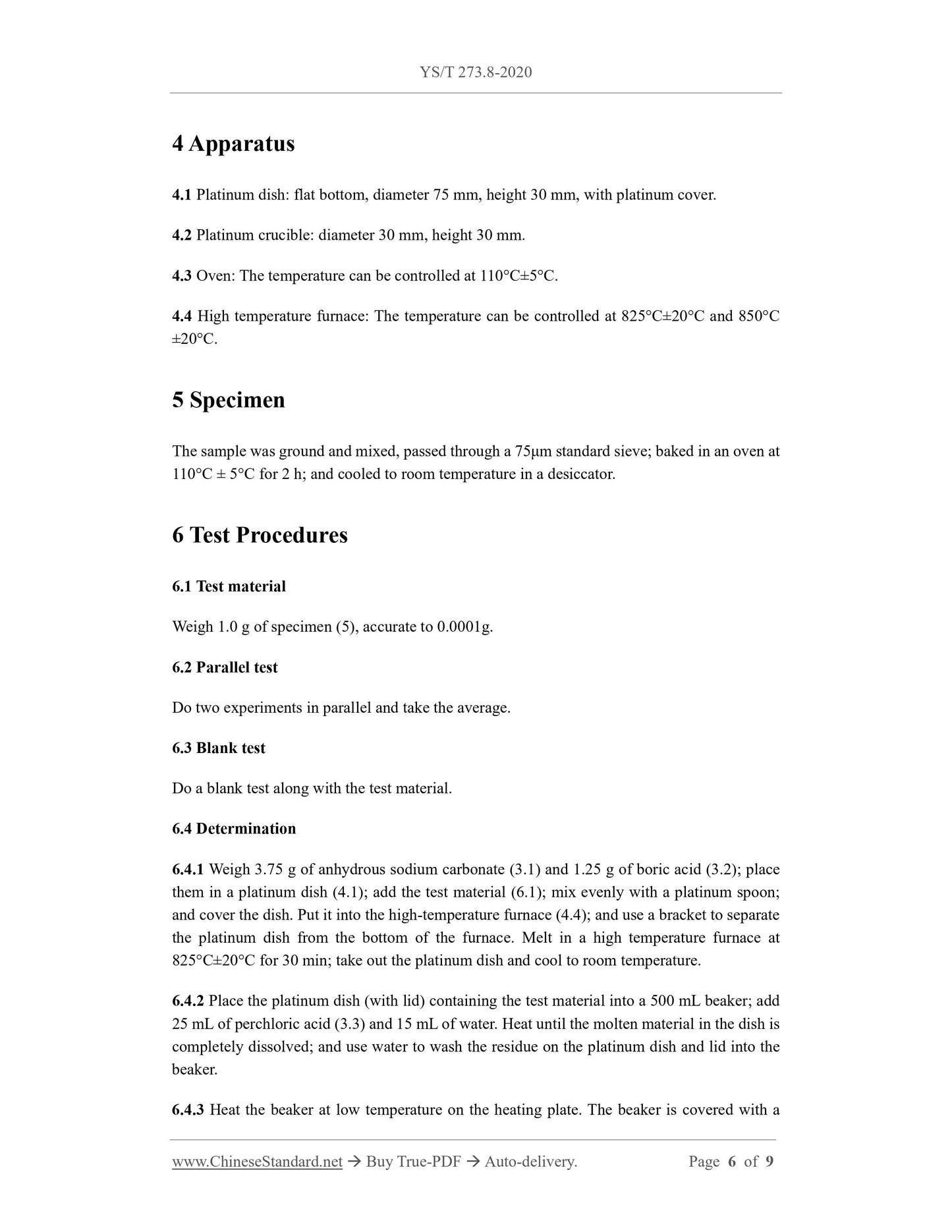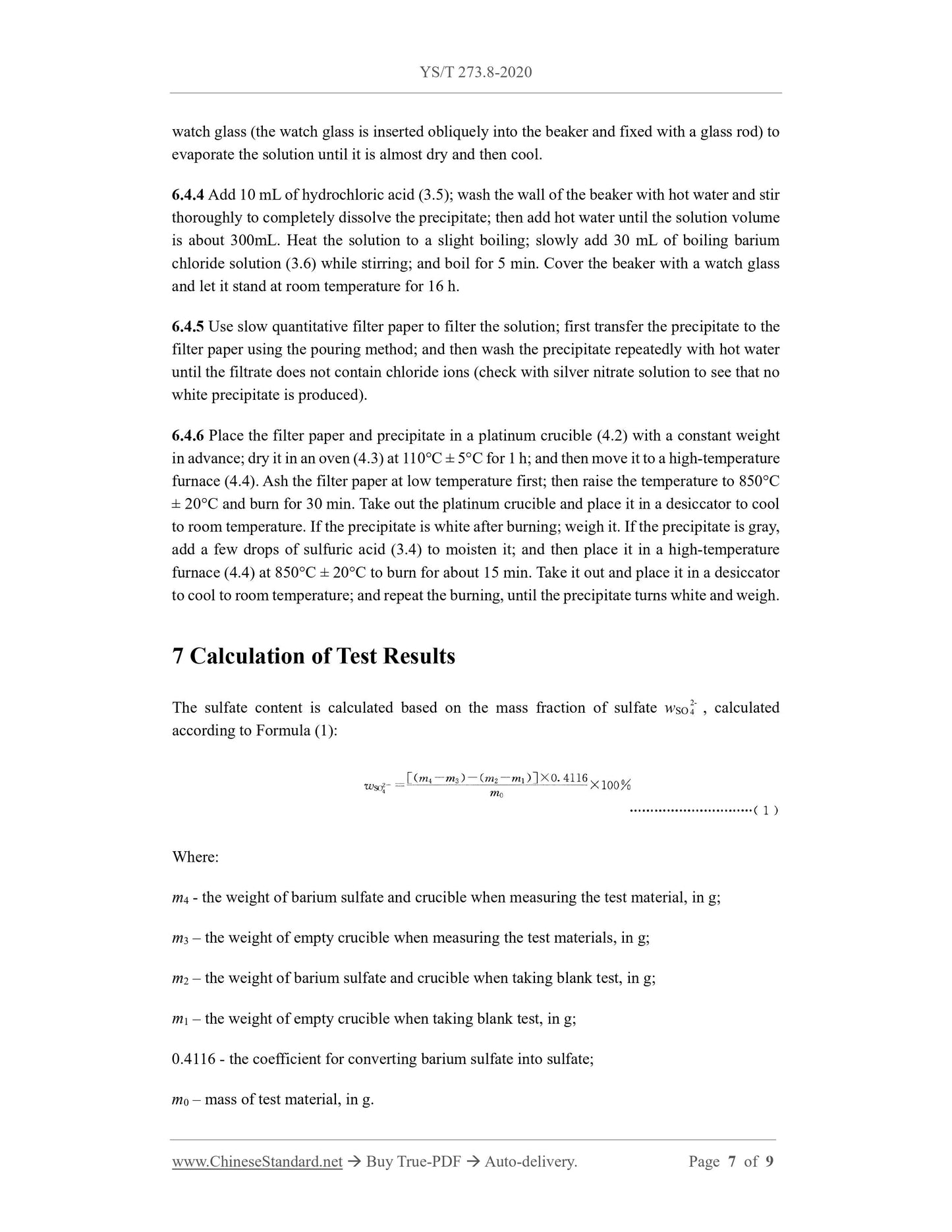1
/
จาก
5
PayPal, credit cards. Download editable-PDF and invoice in 1 second!
YS/T 273.8-2020 English PDF (YST273.8-2020)
YS/T 273.8-2020 English PDF (YST273.8-2020)
ราคาปกติ
$80.00 USD
ราคาปกติ
ราคาโปรโมชัน
$80.00 USD
ราคาต่อหน่วย
/
ต่อ
ค่าจัดส่งที่คำนวณในขั้นตอนการชำระเงิน
ไม่สามารถโหลดความพร้อมในการรับสินค้าด้วยตนเองได้
Delivery: 3 seconds. Download true-PDF + Invoice.
Get QUOTATION in 1-minute: Click YS/T 273.8-2020
Historical versions: YS/T 273.8-2020
Preview True-PDF (Reload/Scroll if blank)
YS/T 273.8-2020: Methods for chemical analysis and physical properties test of cryolite - Part 8: Determination of sulphate content - Barium sulphate gravimetric method
YS/T 273.8-2020
YS
NON-FERROUS METAL INDUSTRY STANDARD
OF THE PEOPLE’S REPUBLIC OF CHINA
ICS 71.100.10
H 30
Replacing YS/T 273.8-2006
Methods for Chemical Analysis and Physical Properties Test
of Cryolite – Part 8: Determination of Sulphate Content –
Barium Sulphate Gravimetric Method
ISSUED ON: DECEMBER 09, 2020
IMPLEMENTED ON: APRIL 1, 2021
Issued by: Ministry of Industry and Information Technology of the People’s
Republic of China
Table of Contents
Foreword ... 3
1 Scope ... 5
2 Method Summary ... 5
3 Reagent ... 5
4 Apparatus ... 6
5 Specimen ... 6
6 Test Procedures ... 6
7 Calculation of Test Results ... 7
8 Precision ... 8
9 Quality Assurance and Control ... 8
10 Test Report ... 8
Methods for Chemical Analysis and Physical Properties Test
of Cryolite – Part 8: Determination of Sulphate Content –
Barium Sulphate Gravimetric Method
1 Scope
This Part specifies the method for determination of sulfate content in cryolite.
This Part applies to the determination of sulfate content in cryolite. Determination range:
0.10%~1.50%.
2 Method Summary
The test material is melted by a mixed flux of sodium carbonate and boric acid; and the melt is
dissolved by perchloric acid. In the acidic medium, barium chloride is used to precipitate sulfate
ions. The precipitated barium sulfate is burned at 850°C and weighed. Calculate sulfate content.
3 Reagent
Unless otherwise stated, only reagents and deionized water determined to be of analytically
pure were used in the analysis.
3.1 Anhydrous sodium carbonate.
3.2 Boric acid.
3.3 Perchloric acid (ρ≈1.67 g/mL).
3.4 Sulfuric acid (ρ=1.84 g/mL).
3.5 Hydrochloric acid (1+1).
3.6 Barium chloride solution: Weigh 61g of barium chloride dihydrate, dissolve it in water and
dilute it to 1L.
3.7 Silver nitrate-nitric acid solution: Weigh 0.5 g of silver nitrate and dissolve it in a small
amount of water; add 10 mL of nitric acid (ρ = 1. 40 g/mL), dilute with water to 100 mL, and
mix well.
4 Apparatus
4.1 Platinum dish: flat bottom, diameter 75 mm, height 30 mm, with platinum cover.
4.2 Platinum crucible: diameter 30 mm, height 30 mm.
4.3 Oven: The temperature can be controlled at 110°C±5°C.
4.4 High temperature furnace: The temperature can be controlled at 825°C±20°C and 850°C
±20°C.
5 Specimen
The sample was ground and mixed, passed through a 75μm standard sieve; baked in an oven at
110°C ± 5°C for 2 h; and cooled to room temperature in a desiccator.
6 Test Procedures
6.1 Test material
Weigh 1.0 g of specimen (5), accurate to 0.0001g.
6.2 Parallel test
Do two experiments in parallel and take the average.
6.3 Blank test
Do a blank test along with the test material.
6.4 Determination
6.4.1 Weigh 3.75 g of anhydrous sodium carbonate (3.1) and 1.25 g of boric acid (3.2); place
them in a platinum dish (4.1); add the test material (6.1); mix evenly with a platinum spoon;
and cover the dish. Put it into the high-temperature furnace (4.4); and use a bracket to separate
the platinum dish from the bottom of the furnace. Melt in a high temperature furnace at
825°C±20°C for 30 min; take out the platinum dish and cool to room temperature.
6.4.2 Place the platinum dish (with lid) containing the test material into a 500 mL beaker; add
25 mL of perchloric acid (3.3) and 15 mL of water. Heat until the molten material in the dish is
completely dissolved; and use water to wash the residue on the platinum dish and lid into the
beaker.
6.4.3 Heat the beaker at low temperature on the heating plate. The beaker is covered with a
watch glass (the watch glass is inserted obliquely into the beaker and fixed with a glass rod) to
evaporate the solution until it is almost dry and then cool.
6.4.4 Add 10 mL of hydrochloric acid (3.5); wash the wall of the beaker with hot water and stir
thoroughly to completely dissolve the precipitate; then add hot water until the solution volume
is about 300mL. Heat the solution to a slight boiling; slowly add 30 mL of boiling barium
chloride solution (3.6) while stirring; and boil for 5 min. Cover the beaker with a watch glass
and let it stand at room temperature for 16 h.
6.4.5 Use slow quantitative filter paper to filter the solution; first transfer the precipitate to the
filter paper using the pouring method; and then wash the precipitate repeatedly with hot water
until the filtrate does not contain chloride ions (check with silver nitrate solution to see that no
white precipitate is produced).
6.4.6 Place the filter paper and precipitate in a platinum crucible (4.2) with a constant weight
in advance; dry it in an oven (4.3) at 110°C ± 5°C for 1 h; and then move it to a high-temperature
furnace (4.4). Ash the filter paper at low temperature first; then raise the temperature to 850°C
± 20°C and burn for 30 min. Take out the platinum crucible and place it in a desiccator to cool
to room temperature. If the precipitate is white after burning; weigh it. If the precipitate is gray,
add a few drops of sulfuric acid (3.4) to moisten it; and then place it in a high-temperature
furnace (4.4) at 850°C ± 20°C to burn for about 15 min. Take it out and place it in a desiccator
to cool to room temperature; and repeat the burning, until the precipitate turns white and weigh.
7 Calculation of Test Results
The sulfate content is calculated based on the mass fraction of sulfate wSO 2- 4 , calculated
according to Formula (1):
Where:
m4 - the weight of barium sulfate and crucible when measuring the test material, in g;
m3 – the weight of empty crucible when measuring the test materials, in g;
m2 – the weight of barium sulfate and crucible when taking blank test, in g;
m1 – the weight of empty crucible when taking blank test, in g;
0.4116 - the coefficient for converting barium sulfate into sulfate;
m0 – mass of test material, in g.
Get QUOTATION in 1-minute: Click YS/T 273.8-2020
Historical versions: YS/T 273.8-2020
Preview True-PDF (Reload/Scroll if blank)
YS/T 273.8-2020: Methods for chemical analysis and physical properties test of cryolite - Part 8: Determination of sulphate content - Barium sulphate gravimetric method
YS/T 273.8-2020
YS
NON-FERROUS METAL INDUSTRY STANDARD
OF THE PEOPLE’S REPUBLIC OF CHINA
ICS 71.100.10
H 30
Replacing YS/T 273.8-2006
Methods for Chemical Analysis and Physical Properties Test
of Cryolite – Part 8: Determination of Sulphate Content –
Barium Sulphate Gravimetric Method
ISSUED ON: DECEMBER 09, 2020
IMPLEMENTED ON: APRIL 1, 2021
Issued by: Ministry of Industry and Information Technology of the People’s
Republic of China
Table of Contents
Foreword ... 3
1 Scope ... 5
2 Method Summary ... 5
3 Reagent ... 5
4 Apparatus ... 6
5 Specimen ... 6
6 Test Procedures ... 6
7 Calculation of Test Results ... 7
8 Precision ... 8
9 Quality Assurance and Control ... 8
10 Test Report ... 8
Methods for Chemical Analysis and Physical Properties Test
of Cryolite – Part 8: Determination of Sulphate Content –
Barium Sulphate Gravimetric Method
1 Scope
This Part specifies the method for determination of sulfate content in cryolite.
This Part applies to the determination of sulfate content in cryolite. Determination range:
0.10%~1.50%.
2 Method Summary
The test material is melted by a mixed flux of sodium carbonate and boric acid; and the melt is
dissolved by perchloric acid. In the acidic medium, barium chloride is used to precipitate sulfate
ions. The precipitated barium sulfate is burned at 850°C and weighed. Calculate sulfate content.
3 Reagent
Unless otherwise stated, only reagents and deionized water determined to be of analytically
pure were used in the analysis.
3.1 Anhydrous sodium carbonate.
3.2 Boric acid.
3.3 Perchloric acid (ρ≈1.67 g/mL).
3.4 Sulfuric acid (ρ=1.84 g/mL).
3.5 Hydrochloric acid (1+1).
3.6 Barium chloride solution: Weigh 61g of barium chloride dihydrate, dissolve it in water and
dilute it to 1L.
3.7 Silver nitrate-nitric acid solution: Weigh 0.5 g of silver nitrate and dissolve it in a small
amount of water; add 10 mL of nitric acid (ρ = 1. 40 g/mL), dilute with water to 100 mL, and
mix well.
4 Apparatus
4.1 Platinum dish: flat bottom, diameter 75 mm, height 30 mm, with platinum cover.
4.2 Platinum crucible: diameter 30 mm, height 30 mm.
4.3 Oven: The temperature can be controlled at 110°C±5°C.
4.4 High temperature furnace: The temperature can be controlled at 825°C±20°C and 850°C
±20°C.
5 Specimen
The sample was ground and mixed, passed through a 75μm standard sieve; baked in an oven at
110°C ± 5°C for 2 h; and cooled to room temperature in a desiccator.
6 Test Procedures
6.1 Test material
Weigh 1.0 g of specimen (5), accurate to 0.0001g.
6.2 Parallel test
Do two experiments in parallel and take the average.
6.3 Blank test
Do a blank test along with the test material.
6.4 Determination
6.4.1 Weigh 3.75 g of anhydrous sodium carbonate (3.1) and 1.25 g of boric acid (3.2); place
them in a platinum dish (4.1); add the test material (6.1); mix evenly with a platinum spoon;
and cover the dish. Put it into the high-temperature furnace (4.4); and use a bracket to separate
the platinum dish from the bottom of the furnace. Melt in a high temperature furnace at
825°C±20°C for 30 min; take out the platinum dish and cool to room temperature.
6.4.2 Place the platinum dish (with lid) containing the test material into a 500 mL beaker; add
25 mL of perchloric acid (3.3) and 15 mL of water. Heat until the molten material in the dish is
completely dissolved; and use water to wash the residue on the platinum dish and lid into the
beaker.
6.4.3 Heat the beaker at low temperature on the heating plate. The beaker is covered with a
watch glass (the watch glass is inserted obliquely into the beaker and fixed with a glass rod) to
evaporate the solution until it is almost dry and then cool.
6.4.4 Add 10 mL of hydrochloric acid (3.5); wash the wall of the beaker with hot water and stir
thoroughly to completely dissolve the precipitate; then add hot water until the solution volume
is about 300mL. Heat the solution to a slight boiling; slowly add 30 mL of boiling barium
chloride solution (3.6) while stirring; and boil for 5 min. Cover the beaker with a watch glass
and let it stand at room temperature for 16 h.
6.4.5 Use slow quantitative filter paper to filter the solution; first transfer the precipitate to the
filter paper using the pouring method; and then wash the precipitate repeatedly with hot water
until the filtrate does not contain chloride ions (check with silver nitrate solution to see that no
white precipitate is produced).
6.4.6 Place the filter paper and precipitate in a platinum crucible (4.2) with a constant weight
in advance; dry it in an oven (4.3) at 110°C ± 5°C for 1 h; and then move it to a high-temperature
furnace (4.4). Ash the filter paper at low temperature first; then raise the temperature to 850°C
± 20°C and burn for 30 min. Take out the platinum crucible and place it in a desiccator to cool
to room temperature. If the precipitate is white after burning; weigh it. If the precipitate is gray,
add a few drops of sulfuric acid (3.4) to moisten it; and then place it in a high-temperature
furnace (4.4) at 850°C ± 20°C to burn for about 15 min. Take it out and place it in a desiccator
to cool to room temperature; and repeat the burning, until the precipitate turns white and weigh.
7 Calculation of Test Results
The sulfate content is calculated based on the mass fraction of sulfate wSO 2- 4 , calculated
according to Formula (1):
Where:
m4 - the weight of barium sulfate and crucible when measuring the test material, in g;
m3 – the weight of empty crucible when measuring the test materials, in g;
m2 – the weight of barium sulfate and crucible when taking blank test, in g;
m1 – the weight of empty crucible when taking blank test, in g;
0.4116 - the coefficient for converting barium sulfate into sulfate;
m0 – mass of test material, in g.
Share
